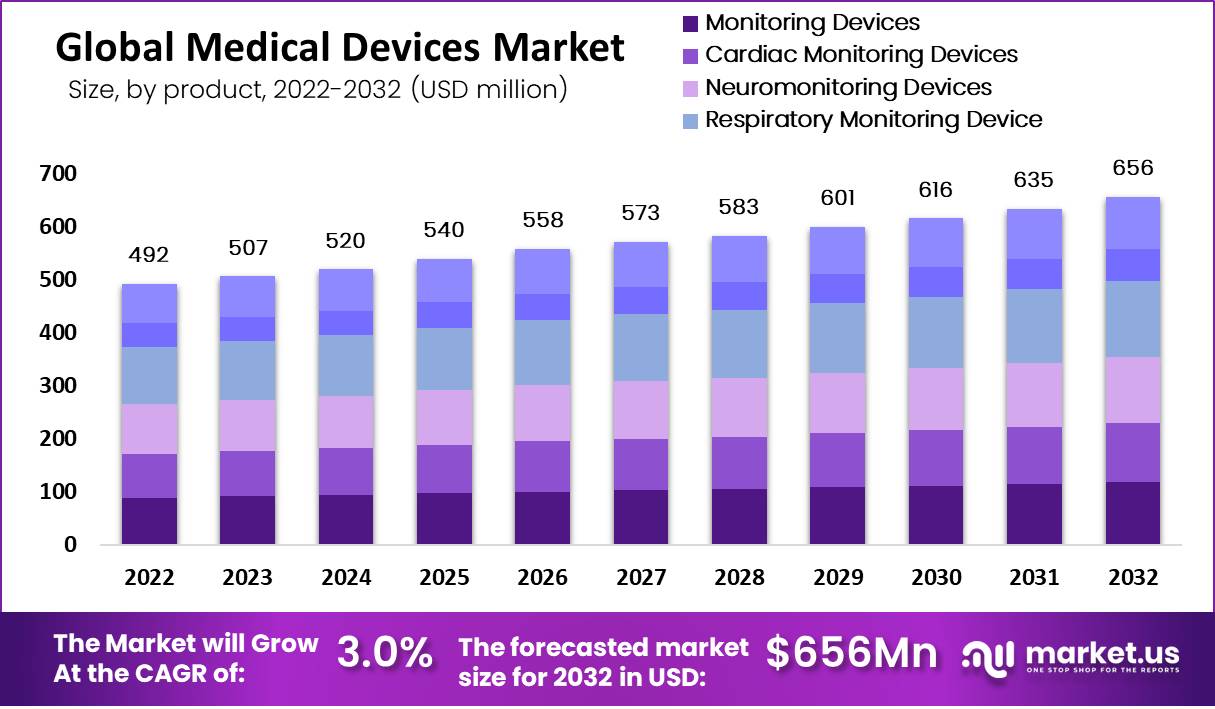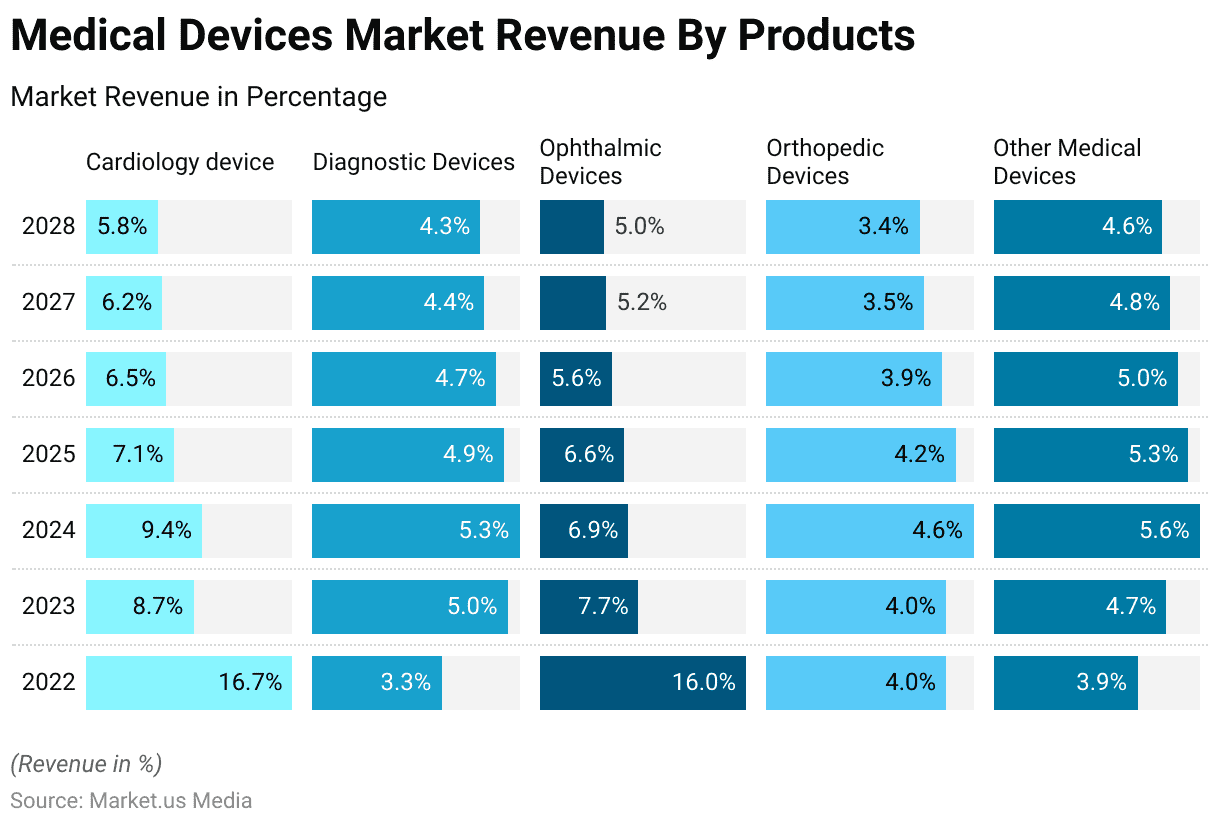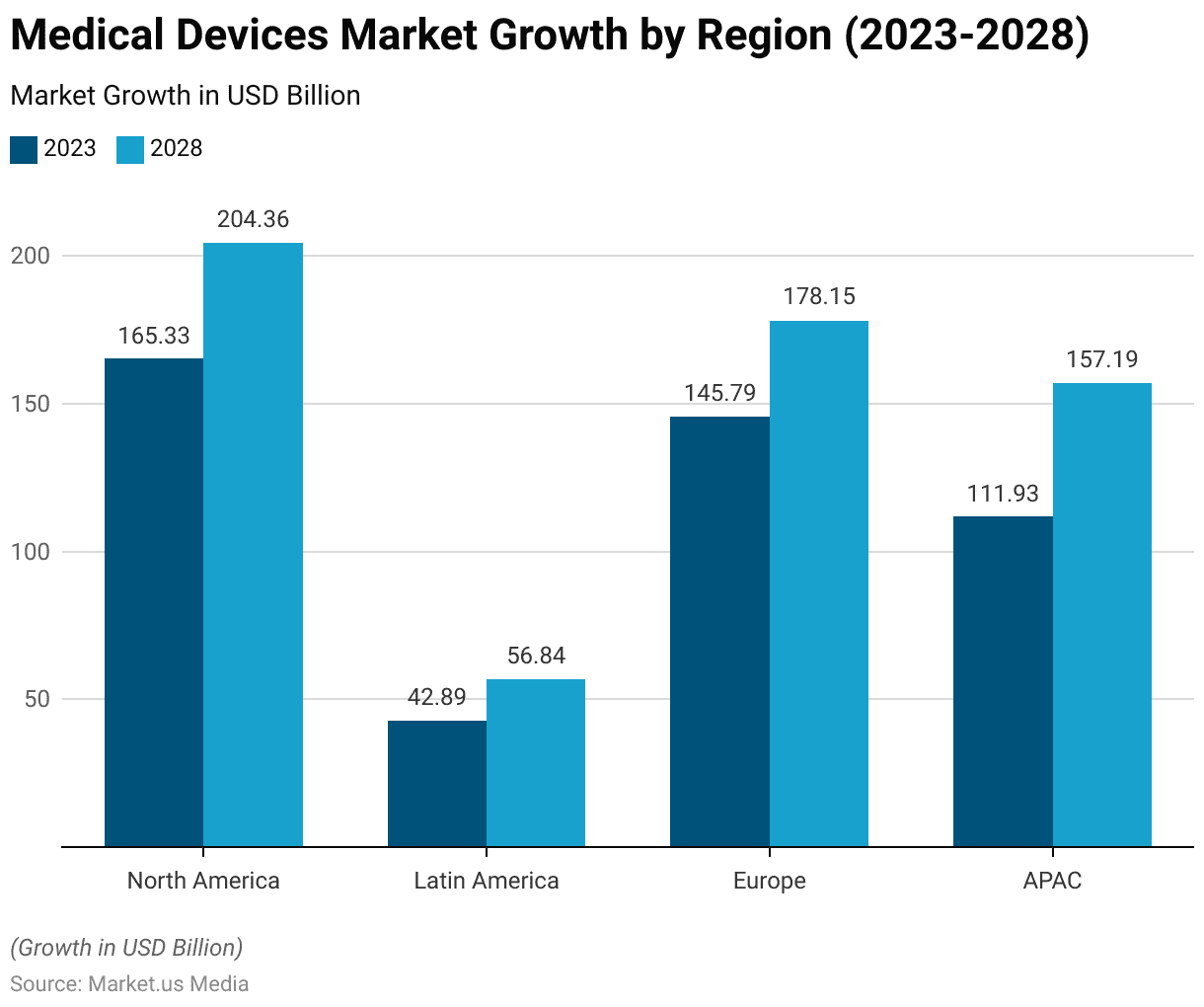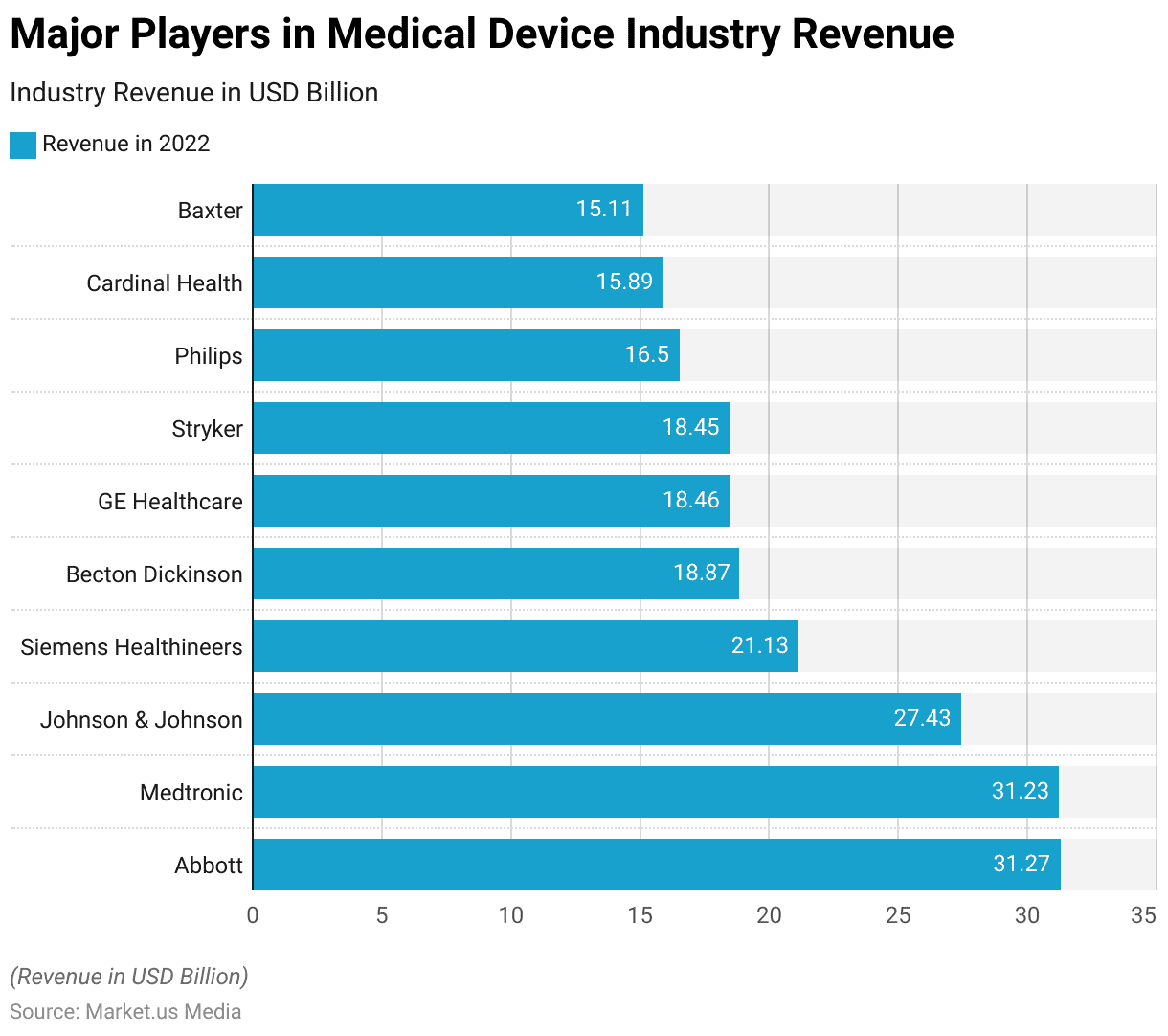Table of Contents
- Introduction
- Editor’s Choice
- Medical Devices Market Statistics
- In-Vitro Diagnostics Market Overview
- Global Surgical Equipment Market Statistics
- Regional Analysis of the Medical Devices Market Statistics
- Factors Impacting The Use Of Medical Devices
- Key Players in the Medical Devices Industry Statistics
- Recent Developments
- Conclusion
- FAQs
Introduction
Medical Devices Statistics: Medical devices are crucial tools in healthcare, encompassing diagnostic, therapeutic, monitoring, and assistive devices, along with software used for medical purposes.
The global medical device market is valued at over $450 billion, driven by an aging population and technological advancements. Regulatory bodies like the FDA oversee the safety of these devices.
Recent innovations include wearables and AI-driven diagnostics. The COVID-19 pandemic heightened the demand for devices like ventilators.
Major players in the industry include Medtronic and Johnson & Johnson. While medical devices have greatly improved patient outcomes, safety concerns, and regulatory hurdles persist.

Editor’s Choice
- The medical devices market has exhibited an exponential growth in recent years. With a clear upward trajectory in revenue at a compound annual growth rate (CAGR) of 3%
- In 2022, the market generated approximately $492 Billion in revenue.
- The medical device market is expected to grow significantly, with revenue forecasted to reach $656 Billion in 2032.
- The US dominates the global market with 39%.
- Cardiovascular devices occupy the largest market currently, with about 16% market.
- Abbott Laboratories and Medtronic are the top companies dealing with medical devices with annual revenues of about $31.23 billion and $31.27 billion.

Medical Devices Market Statistics
Global Medical Devices Market Size Statistics
- The Medical Devices industry is poised for consistent growth in the coming years. Starting at $492 Billion in 2022, it is expected to steadily increase with projected revenues of $507 Billion in 2023 and $520 Billion in 2024.
- The growth trajectory continues with estimates of $540 Billion in 2025 and $558 Billion in 2026.
- In 2027, the industry is forecasted to reach $573 Billion, followed by $583 Billion in 2028.
- The upward rise continues into 2029 with a revenue of $601 Billion and through to 2030 with an expected $616 Billion.
- Beyond that, the outlook remains robust, with revenue projections of $635 Billion in 2031 and $656 Billion in 2032.
(Source: Market.us)

Medical Devices Market Share By – Products Statistics
- Since 2022, Cardiology devices have occupied the top market share and are expected to remain the top player until the forecasted period.
- In 2022, Cardiology devices held about 16.7% of the market share, followed by Ophthalmology devices with 16%.
- Diagnostic imaging devices held the lowest market share of 3.3% in 2022.
- 2023, saw shifts in these percentages, with Cardiology Devices decreasing to 8.7%. Diagnostic Devices increased to 5%, and Ophthalmic Devices rised to 7.7%. Orthopedic Devices remaining at 4%, and Other Medical Devices increased to 4.7%.
- In 2024, Cardiology Devices captured 9.4% of the market, while Diagnostic Devices represented 5.3%. Ophthalmic Devices accounted for 6.9%, Orthopedic Devices held 4.6%, and Other Medical Devices contributed 5.6%.
- In the subsequent year, 2025, Cardiology Devices decreased to 7.1%, and Diagnostic Devices were at 4.9%. Ophthalmic Devices represented 6.6%, Orthopedic Devices were at 4.2%, and Other Medical Devices stood at 5.3%.
- In 2026, Cardiology Devices will be at 6.5% and diagnostic Devices at 4.7%. Ophthalmic Devices at 5.6%, Orthopedic Devices at 3.9%, and Other Medical Devices at 5%.
- In 2027, Cardiology Devices decreased to 6.2%, Diagnostic Devices were at 4.4%. Ophthalmic Devices represented 5.2%, Orthopedic Devices held 3.5%, and Other Medical Devices contributed 4.8%.
- Finally, in 2028, Cardiology Devices accounted for 5.8%, Diagnostic Devices were at 4.3%, Ophthalmic Devices represented 5%. Orthopedic Devices held 3.4%, and Other Medical Devices contributed 4.6%. These percentages reflect the evolving dynamics in the market share of these product categories during this period.
- At the end of the forecast period, diagnostic imaging devices are expected to take the second spot in the market.
(Source: Statista)

In-Vitro Diagnostics Market Overview
- In-vitro Diagnostics is expected to grow in the coming years. In 2022, the market revenue was 91.2 billion US dollars and is expected to reach 118 billion US dollars by 2030 at a CAGR of 3.2%.
- Revenue is expected to increase to $95 billion in 2023 and $98.5 billion in 2024. It will continue to grow towards $101.9 billion in 2025 and $105.4 billion in 2026.
- In 2027, the industry is forecasted to reach $108.8 billion, followed by $112.1 billion in 2028.
- The positive growth trend extends to 2029, with a projected revenue of $115.4 billion, and culminates in 2030 with an expected revenue of $118.6 billion.
(Source: Statista)
Take advantage of our unbeatable offer - buy now!


Global Surgical Equipment Market Statistics
- The worldwide surgical equipment market has grown significantly, with a value of $35.6 billion in 2022. It is anticipated to continue this upward trend, reaching approximately $59 billion by 2032 at an annual rate of 5.2%.
- These numbers reflect the market’s robust performance and its potential for continued expansion over the coming decade, driven by advancements in surgical technology and a rising demand for surgical procedures on a global scale.
- In 2020, the global market for implantable medical devices was $91,868.94 million. Predictions point to significant growth, with an expected value of $179,032.75 million by 2030.
- In 2022, the global market for monitoring medical devices was valued at $42.3 billion. By 2027, it is expected to reach $65.4 billion at a CAGR of 9.1%.
- In 2022, the disabled assistive devices market was valued at $22,439.00 million. Projections suggest substantial growth, with an anticipated value of $37,263.00 million by 2030. This growth is expected to occur at an annual rate of 5.9% between 2023 and 2030.
- The global market for dental medical devices in 2022 was $6.5 billion and will reach $8.7 billion by 2027. The CAGR is at 6.1% for the forecast period.
- The global market for home healthcare medical devices in 2022 was worth $226 billion and will reach $340.2 billion by 2027 at a CAGR of 8.5% for the forecast period.
- Laboratory services devices will reach $17.7 billion in 2024 compared to $9.5 billion in 2019. It grew at a CAGR of 13.4%.
Regional Analysis of the Medical Devices Market Statistics
- Key players apart from the US are Spain, Germany, Japan, Italy, and the Netherlands.
- North America– The market size for this region was recorded to be $165.33 billion in 2023. And is forecasted to steadily grow at a CAGR of 4.33% and reach up to $204.36 billion by 2028.
- Latin America— The market size for this region was recorded to be $42.89 billion in 2023. It is forecasted to steadily grow at a CAGR of %5.79 and reach up to $56.84 billion by 2028. Brazil was the largest market share holder in 2021 at 39.8% and will remain at the top. Other fast-growing regions are Argentina and Mexico, at a rate of 11.2% and 10.5 % respectively.
- Europe- The market size for this region was recorded to be $145.79 billion in 2023. It will grow at a CAGR of 4.09% and reach up to $178.15 billion by 2028.
- APAC- The market of this region was $111.93 billion in 2023 and will reach $157.19 billion in 2028 at a CAGR of 6.8%.
- Middle East & Africa- The market is expected to reach $21,802.3 million in 2027 from $16,597.4 million in 2019, at a CAGR of 3.6%.
(Source: Statista)

Factors Impacting The Use Of Medical Devices
- In 2021, the United States had a 6.8% heart disease prevalence. This is 1.8% more than the total population.
- Type 2 Diabetes affects 27,000 individuals, signifying its prevalence as a chronic health condition. Heart Disease, with 10,300 cases, underscores its significant impact on public health.
- Stroke reported at 2,200 cases, is a sudden and serious medical event, with 405 reported deaths, emphasizing the importance of prevention and prompt medical care.
- Myocardial Injuries, totaling 1,500 cases, and 350 deaths attributed to Coronary Diseases, highlighting the need for ongoing efforts to reduce mortality and improve public health outcomes.
- In India, the senior population is forecasted to reach 193.8 million in 2031, among them 92.9 million elderly males and 100.9 million elderly females. This will lead to an increase in the usage of medical devices especially in highly populated countries like India and China.
(Source: Market.us)

Key Players in the Medical Devices Industry Statistics
- The top 15 players hold approximately 43.60% of the market share. Abbott secured the top spot with $31.27 billion in revenue, closely trailed by Medtronic at $31.23 billion.
- Johnson & Johnson reported revenue of $27.43 billion, while Siemens Healthineers disclosed a figure of $21.13 billion.
- Becton Dickinson’s revenue was $18.87 billion, followed by GE Healthcare and Stryker, earning revenues of $18.46 billion and $18.45 billion, respectively.
- Philips earned $16.5 billion in revenue.
- Cardinal Health and Baxter generated $15.89 billion and $15.11 billion in revenue, respectively.
- These numbers offer insights into how these healthcare firms fared financially in 2022 and highlight their positions within the competitive healthcare and medical device sectors.

Recent Developments
Acquisitions and Mergers:
- In the past quarter, the medical devices sector witnessed a surge in mergers and acquisitions, totaling 25 transactions globally. Notable among these was the acquisition of Medtronic by Abbott Laboratories, a deal valued at $23 billion, aimed at expanding Abbott’s cardiovascular device portfolio.
- Smith & Nephew’s acquisition of Integra Lifesciences’ extremity orthopedics business for $240 million bolstered its position in the orthopedic implants market.
New Product Launches:
- The medical devices industry introduced 68 new products in the previous quarter. Among the highlights was the launch of Johnson & Johnson’s VELYS™ Robotic-Assisted Solution, designed for minimally invasive surgery, expected to streamline procedures and enhance surgical outcomes.
- Dexcom’s release of the G7 continuous glucose monitoring system marked a significant advancement in diabetes management technology, offering improved accuracy and convenience for patients.
Funding and Investments:
- Venture capital funding in the medical devices sector amounted to $2.4 billion in the last quarter, indicating sustained investor interest in innovative healthcare solutions. Notable investments include a $150 million funding round secured by Butterfly Network for its handheld ultrasound technology, aimed at expanding accessibility to diagnostic imaging.
- Furthermore, public offerings in the medical devices space raised approximately $3.1 billion, with IPOs from companies such as Renalytix AI, a developer of artificial intelligence-enabled diagnostics for kidney disease, garnering significant attention from investors.
Regulatory Approvals:
- Regulatory approvals for medical devices surged by 15% compared to the previous quarter, with 98 devices receiving clearance from regulatory authorities worldwide. This includes FDA approval for Boston Scientific’s WATCHMAN FLX™ left atrial appendage closure device, offering a minimally invasive alternative for stroke prevention in atrial fibrillation patients.
- Additionally, the European CE Mark approval for Siemens Healthineers’ MAGNETOM Free. Max MRI system expanded diagnostic capabilities in magnetic resonance imaging, catering to the evolving needs of healthcare providers.
Market Performance:
- The global medical devices market witnessed a steady growth rate of 4.7% in the previous quarter, reaching a valuation of $456 billion. This growth can be attributed to the increasing demand for advanced healthcare solutions, coupled with the rising prevalence of chronic diseases globally.
- Segment-wise, the diagnostic imaging devices sector experienced the highest growth, with a 6.2% increase in revenue, driven by technological advancements and the growing adoption of imaging modalities for diagnosis and treatment planning.
Conclusion
Medical Devices Statistics – In conclusion, many factors play a role in expanding the medical devices industry like the aging population, the prevalence of chronic diseases, and evolving healthcare technologies.
As these factors continue to grow in numbers, the demand for medical devices is expected to rise, especially in orthopedics, cardiovascular care, and diagnostic imaging.
Challenges like healthcare access and disparities highlight the importance of addressing healthcare equity. Improvement in patient outcomes and enhancing the quality of healthcare delivery will grow with advancements in technology and research qualities.
To navigate this dynamic field effectively, stakeholders must remain vigilant in monitoring trends and adapting to the changing healthcare landscape to meet the evolving needs of patients worldwide.
FAQs
Medical devices are instruments, equipment, or products used for diagnosing, treating, monitoring, or preventing medical conditions in patients.
Medical devices can be categorized into various classes, including diagnostic devices, surgical instruments, in vitro diagnostic tests, implantable devices (e.g., pacemakers), and more.
Medical devices are physical instruments or equipment used in healthcare, while pharmaceutical products are drugs or medications ingested, injected, or applied to the body.
Yes, like any medical intervention, medical devices carry some risk. Risks can include device malfunction, infection, or adverse reactions. Healthcare professionals should assess and mitigate these risks.
Medical devices are physical instruments or tools used for medical purposes, while pharmaceutical products are medications or drugs intended to diagnose, treat, or prevent diseases.
Discuss your needs with our analyst
Please share your requirements with more details so our analyst can check if they can solve your problem(s)



